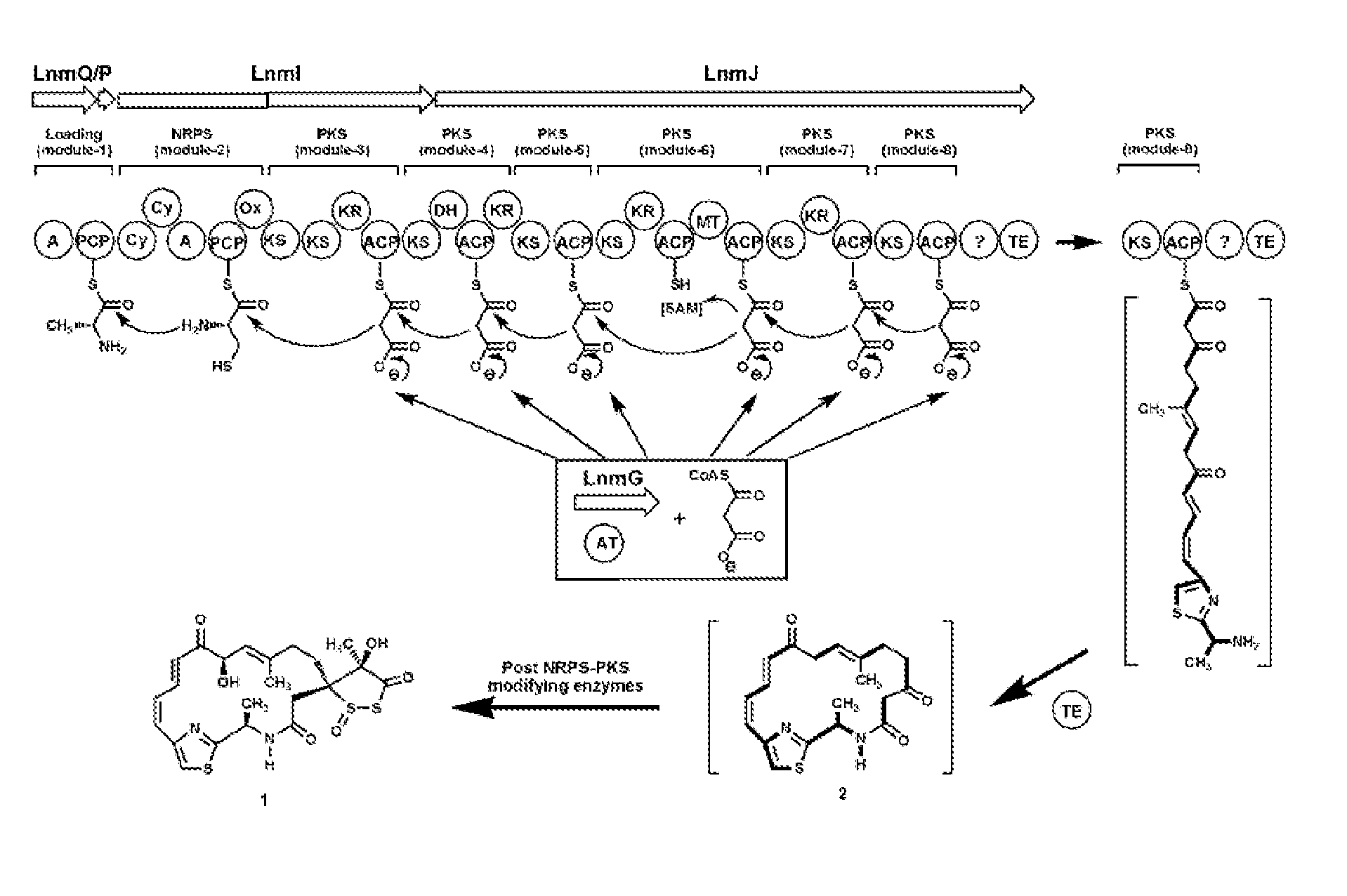Discrete acyltransferases associated with type I polyketide synthases and methods of use
a polyketide and acyltransferase technology, applied in the field of polyketide synthesis, can solve the problems of limited functional group access for chemical modification, limited practical value of chemical total synthesis, etc., and achieve the effect of increasing stability and half-life of such molecules and facilitating the addition of additional moieties
- Summary
- Abstract
- Description
- Claims
- Application Information
AI Technical Summary
Benefits of technology
Problems solved by technology
Method used
Image
Examples
example 1
The Biosynthetic Gene Cluster for the Antitumor Macrolactam Leinamycin from Streptomyces atroolivaceus: a Novel Approach for Identifying and Cloning Thiazole Biosynthetic Genes
[0202]In this example, we describe (1) the construction of a cosmid library of S. atroolivaceus, (2) PCR amplification of a conserved cyclase-domain probe, (3) identification and mapping of overlapping cosmid clones that cover the target Lnm biosynthetic gene cluster and flanking regions, (4) the purification, HPLC and mass spectral (MS) analyses of Lnm production in S. atrooliveceus, (5) the sequencing and sequence analysis of a 11 kb DNA from the gene cluster, (6) the development of a genetic system, and (7) the confirmation of cloned gene cluster encoding Lnm biosyntheses by gene disruption to generate Lnm non-producing mutants.
Materials and Methods
[0203]Genomic DNA Isolation.
[0204]Standard protocols are followed in this study (Kieser et al. (2000) Practical Streptomyces genetics. The John Innes Foundation,...
example 2
A Discrete Acyltransferase Associated with a Type I Polyketide Synthase
[0244]In this example, we describe the in vitro loading of ACP domains of leinamycin PKS by LnmG, a discrete AT (SEQ ID NO 257). We have previously cloned the lnmGHI genes (SEQ ID NOs 43–45), demonstrated that this locus is essential for leinamycin production, and localized the lnm biosynthesis gene cluster to a 172-kilobase (kb) DNA region from S. atroolivaceus S-140 (SEQ ID NO 1). DNA sequence analysis of the four overlapping cosmids, pBS3004, pBS3005, pBS3006, and pBS3007, revealed 72 open reading frames (ORFs). Sequential inactivation of ORFs from both ends of the sequenced region led to the assignment of the lnm gene cluster to consist of 27 ORFs, of which two (lnmQ (SEQ ID NO 51) and lnmP (SEQ ID NO 82)) encode nonribosomal peptide synthetase (NRPS), one (lnmI) (SEQ ID NO 45) encodes a hybrid NRPS-PKS, and one (lnmJ) (SEQ ID NO 46) encode a PKS (FIG. 11).
Materials and Methods
[0245]Sequence Analysis of the l...
PUM
| Property | Measurement | Unit |
|---|---|---|
| Tm | aaaaa | aaaaa |
| volume | aaaaa | aaaaa |
| temperature | aaaaa | aaaaa |
Abstract
Description
Claims
Application Information
 Login to View More
Login to View More - R&D
- Intellectual Property
- Life Sciences
- Materials
- Tech Scout
- Unparalleled Data Quality
- Higher Quality Content
- 60% Fewer Hallucinations
Browse by: Latest US Patents, China's latest patents, Technical Efficacy Thesaurus, Application Domain, Technology Topic, Popular Technical Reports.
© 2025 PatSnap. All rights reserved.Legal|Privacy policy|Modern Slavery Act Transparency Statement|Sitemap|About US| Contact US: help@patsnap.com



